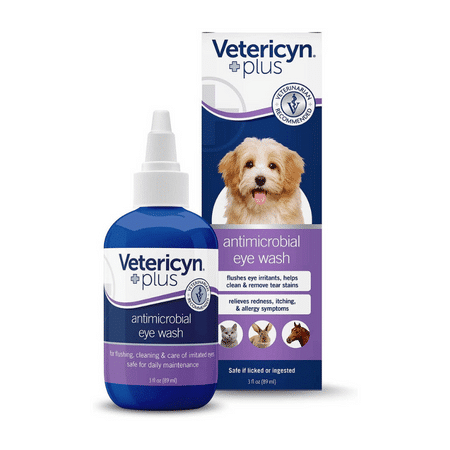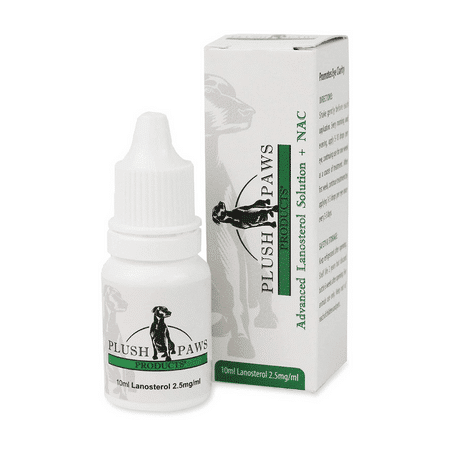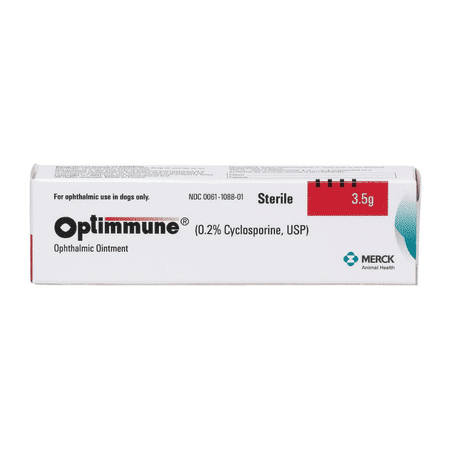When you purchase through links on our site, we may earn a commission. Here’s how it works.

Like humans, dogs’ eyes are vulnerable to infections, injuries, allergens, debris, and other irritating problems. Our furry friends are also prone to several chronic eye conditions that require long-term treatment to save their vision. Some conditions are minor and can be relieved from over-the-counter eye drops for dogs. But many require prescription drops from your veterinarian. We’ll explore the best eye drops for dogs for many different needs and give you tips on how to administer drops to your pup.
Signs Of Eye Problems In Dogs
Several eye conditions share very similar symptoms, so you should seek veterinary attention to get a definitive diagnosis and treatment if you notice any of these signs.
- Redness
- Discharge (may be clear and watery or thicker and yellowish)
- Squinting, blinking, or keeping eye(s) closed
- Eye rubbing
- Cloudiness
- Puffiness/swelling
- Poor vision
Why Would My Dog Need Eye Drops?
Even though our pups have a third eyelid that helps protect their eyes, they’re still at risk of irritation, infection, and other conditions that may require eye drops to heal or prevent further damage. Here are some of the most common reasons dogs need eye drops.
Eye Infections
Dogs can develop eye infections from various bacteria, viruses, injuries, and foreign objects, among other causes. Eye infections can lead to a serious condition called uveitis, an inflammation of the uveal tract of the eye (the middle part of the eye containing the iris). The best dog eye drops for infection depend on the underlying cause.
Conjunctivitis
Conjunctivitis, or pink eye, is an inflammation of the tissue that covers the eye and lines the eyelids (conjunctiva). Symptoms include redness, discharge, and squinting. It’s usually caused by a viral or bacterial infection, allergies, trauma, or an irritating foreign object in the eye.
Allergies
If your dog has allergies to environmental irritants, such as dust mites, mold, pollen, grasses, etc., he may need eye drops to alleviate irritation, swelling, and itchiness. Some dogs suffer from seasonal allergies rather than year-round symptoms. However, not all dogs with allergies suffer from eye problems; skin issues are more common. Allergy eye drops for dogs can be either over-the-counter or prescription, depending on the severity of your pup’s symptoms.
Dry Eye
Dry eye, or keratoconjunctivitis sicca, occurs when the tear glands don’t produce enough tears, causing the cornea to dry out and become inflamed. It’s common in certain breeds, particularly brachycephalic (flat-faced) dogs, such as French Bulldogs and Pugs, because their eyelids don’t close all the way. Other common causes include immune-mediated diseases that damage the tear glands (an inherited disorder that’s not well understood), systemic diseases such as hypothyroidism, and sulfa medications.
Corneal Ulcers
A corneal ulcer is a scratch or injury to the cornea, the eye’s surface layer. This can occur from rough play, an animal scratch, running through tall brush, sand, dirt, or another foreign object embedded under the eyelid, and other causes of eye injury. Corneal ulcers can also develop in dogs with chronic dry eyes. They can be quite painful, causing your dog to squint and rub his eye.
Glaucoma
Glaucoma occurs when too little aqueous (eye) fluid drains from the eye. This fluid buildup creates swelling, pressure, and pain that can eventually lead to vision loss and blindness if untreated. Glaucoma eye drops can help keep the pressure and swelling down, but many dogs will also require surgery.
Cataracts
A cataract is a cloudy area that forms in the normally clear lens of the eye. This clouding prevents light from passing normally through the lens to the back of the eye, resulting in blurry vision. Cataracts in dogs are often genetic but can also be caused by trauma or metabolic diseases such as diabetes.
There are currently no cataract eye drops for dogs that have been scientifically proven to delay the progression of the disease; surgery is the only viable treatment. Vets sometimes prescribe anti-inflammatory eye drops to relieve pain and swelling.
Types Of Canine Eye Drops
Some of the conditions we review above can require one or more of these types of eye drops. The two main kinds are over-the-counter (OTC) non-medicated eye drops and medicated eye drops, which typically require a prescription from your vet but not in some cases.
Over-The-Counter Drops
Fortunately, many eye drops for dogs are available without a prescription. But if your furry friend is experiencing chronic red eyes, lots of discharge, or cloudy eyes, or if you think his eye’s been injured, see your vet as soon as possible. Your vet can help nail down the problem and what treatment your pup needs.
Saline Eye Drops For Dogs

Gentle and safe for pups, saline eye washes are used to flush out dirt and debris. They can also help with mild allergies but aren’t effective for infections or more severe conditions. We recommend Burt’s Bees For Dogs Eye Wash or NutriVet Eye Rinse Liquid For Dogs.
Lubricating Drops For Dry Eyes

Your vet may recommend OTC lubricating eye drops in conjunction with prescription drops to treat dry eye. Lubricating drops, like I-DROP VET PLUS and OptixCare Pet Eye Lube Plus, help comfort dry, itchy, and irritated eyes, so they may help dogs with mild or moderate allergies.
Allergy Eye Drops For Dogs

Other OTC eye drops formulated for dogs may provide better relief from allergy symptoms than saline drops, but check with your vet before using them. Two popular products are Vetericyn Plus Antimicrobial Eye Wash and Vets Preferred Eye Wash.
Dog Eye Drops For Infections

A select few OTC antibiotic eye drops and gels, like Terramycin Antibiotic Ointment, can help treat certain eye infections in pets. However, we recommend getting a diagnosis from your vet before trying to treat an infection on your own. Some infections won’t respond to antibiotics and require a different type of treatment, so it’s best to get your vet’s expert advice.
Lanosterol Eye Drops For Dogs

Has your vet diagnosed your dog with cataracts? Surgery is the only definitive treatment for this progressive condition that robs your dog’s vision fairly quickly. But some OTC eye drop manufacturers claim that their lanosterol drops (e.g., Plush Paws Products Advanced Lanosterol Solution) can help maintain your pup’s vision and clear up the cataract cloudiness. However, lanosterol eye drops alone haven’t been proven to live up to these promises; studies are ongoing. We urge you to discuss the use of these drops with your veterinarian.
OTC lanosterol eye drops are based on the results of one study published in Nature in 2015 and an article in Science about the findings. In the study, researchers found that lanosterol, a biomolecule, could possibly be effective in treating cataracts based on their experiments in rabbits and dogs. However, as many experts (including those at Harvard University) point out, this study didn’t show that lanosterol eye drops by themselves could treat cataracts. In the rabbits, they covered dissected cataractous lenses in a lanosterol solution and didn’t treat the rabbits directly with eye drops. And the dogs first received injections of lanosterol into their eye cavities before getting lanosterol eye drops for six weeks.
Prescription Eye Drops For Dogs

Depending on your pup’s eye problem, your vet may prescribe one or more of these types of ophthalmic drops.
- Antibiotic eye drops for dogs are prescribed to treat bacterial infections and conjunctivitis caused by bacteria. Common eye drops for dog conjunctivitis and bacterial infections include ciprofloxacin, oxytetracycline, tobramycin, or triple-antibiotic ophthalmic ointments.
- Non-steroid anti-inflammatory drug (NSAID) eye drops, such as ketorolac (brand names: Acular, Acuvail), help relieve swelling and pain associated with corneal ulceration, uveitis, and trauma, as well as following ocular surgery.
- Steroid eye drops for dogs, which reduce inflammation and relieve pain, may be prescribed for severe allergies and conjunctivitis. The most common are prednisolone and dexamethasone. Steroid drops, however, can be harmful to corneal ulcers.
- Eye drops for canine glaucomas, such as dorzolamide or timolol, reduce the fluid and lower the eye pressure.
Other Common Drops Your Vet May Prescribe

- Cyclosporine eye drops for dogs (brand names: Restasis and Optimmune), an immunosuppressant, are prescribed to treat chronic keratoconjunctivitis sicca (dry eye).
- Tacrolimus is another prescription eye drop for dogs, like cyclosporine, that can help increase tear production for dogs suffering from dry eye.
- Ofloxacin eye drops for dogs can treat infections caused by certain strains of bacteria in conjunctivitis and corneal ulcers.
- Neo-Poly-Dex ophthalmic drops or ointment is a combination of antibiotics and steroids commonly prescribed for eye infections and inflammation in dogs.
- Atropine sulfate ophthalmic preparations are used to dilate pupils, control eye pain from corneal ulcers and uveitis, and other uses.
Can You Use Human Eye Drops On Dogs?
Can you use Visine on dogs? What about other human drops? Any type of medicated human eye drop is off-limits for dogs. Some saline or lubricating drops for humans may be okay but always check with your veterinarian before administering any product made for humans to your pup.
How To Give A Dog Eye Drops (Video)
Applying dog eye drops or ointment can be challenging if your canine companion isn’t cooperating. When you run into problems getting eye medication into your pup’s eyes, follow the steps in this helpful four-minute video. Lindsay Butzer, DVM, a veterinarian in Boca Raton FL, demonstrates how to put eye drops in a dog and gives you tips on how to check your dog’s eyes for any problems.
Keeping Your Dog’s Eyes Healthy
Early treatment is key with any kind of eye problem to maintain your furry friend’s vision and eye health, but not all conditions can be treated with eye drops. See our comprehensive guide on dog eye problems to learn about other eye conditions your pup may develop. It’s also important to clean your dog’s eyes regularly with tear stain wipes and protect them with dog goggles in situations when wind or debris damage may occur.
Tagged With: Eyes

